Timeline: UK weather's ups and downs
- Published
The Met Office has released the annual statistics for 2012, showing that it was the second wettest year in the UK since national records began in 1910.
Some notable events from previous years include the "big freeze" of December 2010, widespread flooding in 2009, and the July heat wave of 2006.
2012
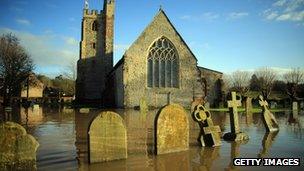
The year was marked by widespread flooding
The year began with politicians, farmers and water industry officials holding a "water summit" to look at supply concerns after a drought warning at the end of the previous year.
In April 2012 a hosepipe ban in the south and south-east of England was in place because of two dry winters. But by July's torrential rain, all restrictions were lifted.
It turned into the wettest spring and the wettest summer in 100 years.
The year continued with such wet weather that crops suffered as farmers struggled with the sodden ground, rivers overflowed, and thousands of properties were flooded.
2011
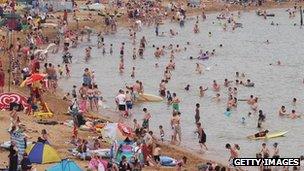
Low rainfall was good for holidaymakers, but not for reservoir levels
This year was the second warmest on record for the UK, according to the Met Office.
It saw high temperatures for lengthy periods, including the warmest April and spring on record, the second warmest autumn and the warmest October day.
The year also saw the driest spring on record in southern England.
By late June temperatures reached 33.1C in Gravesend in Kent - the warmest summer day in more than five years. But it was not to last, as the summer was relatively cool with average temperatures of 13.7C.
The UK set a new record temperature for the month of October when Gravesend recorded 29.9C on 1 October. Wales also secured a new October record when Hawarden reached 28.2C on the same day.
But it was not all good news - some parts of England had very low levels of rainfall, with reservoir levels worrying low after a dry September, October and November.
And Scotland had its wettest year on record with 73.2in (1859.5mm) of rain, beating a previous record set in 1990.
2010
The year began with widespread and disruptive snowfalls in January and February, but it was notable for the "big freeze" of December.
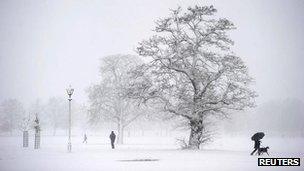
December's snowfall brought disruption... and picturesque scenes
It was the coldest December documented for the UK since nationwide records began 100 years previously.
The period January to June was particularly dry, the driest such period since 1953 generally and since 1929 in north-west England and north Wales.
But a very wet July in the north and the west, following by a very wet August in the south and the east helped offset any rainfall deficits.
2009
February saw heavy snowfalls in many parts of eastern England, with widespread travel disruption. London and parts of Essex, Kent, Surrey and Hampshire were particularly badly affected, but there was also disruption in parts of northern and eastern England. Runways were closed at Heathrow, all London buses were stopped and vehicles were abandoned in the Yorkshire Wolds.
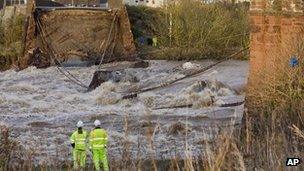
Bridges collapsed after flooding in Workington in November
The last time widespread snowfalls affected the UK was in February 1991.
The summer had been wet too - the third disappointing summer in a row - with the wettest July on record in England and Wales.
Mild, wet weather persisted through November, making it the wettest on record across the UK. Severe flooding occurred in the Lake District.
In Workington, a police officer died after a road bridge collapsed, and the town was effectively cut in half as the remaining road bridge in the town was also severely damaged by floodwaters. Cockermouth was also badly affected by flooding, with the town centre under two metres or more of floodwater.
The year ended with widespread snowfalls, particularly in Scotland, northern and eastern England.
2008
Early September in 2008 saw widespread flooding, with some areas getting up to a month's rainfall in just three days in Wales and eastern England, but up to three month's worth of rain in north-east England.
Morpeth in Northumberland was badly hit with some 1,000 properties flooded.
2007
June and July this year were both exceptionally wet months, with large areas of England and Wales and eastern parts of Northern Ireland having over twice the average rainfall for the two months, and locally three times the average over Gloucestershire, Herefordshire, Nottinghamshire, Worcestershire, Lincolnshire, Yorkshire and the Humber.
2006
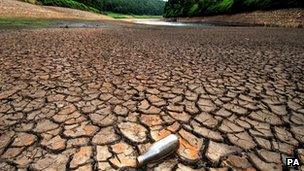
The heatwave of 2006 brought water, rail and health problems
July was the warmest month for the UK since records began in 1914. The hottest single day during the month was at Wisley, Surrey, where temperatures reached 36.5C (97.7F) on 19 July.
But even during the hot, sunny weather there were problems. Heat damage was reported on road surfaces from Cornwall to Cumbria; rail lines buckled, particularly on the West Coast Main Line leading to delays and cancellations; numerous grassland, moorland and forest fires broke out.